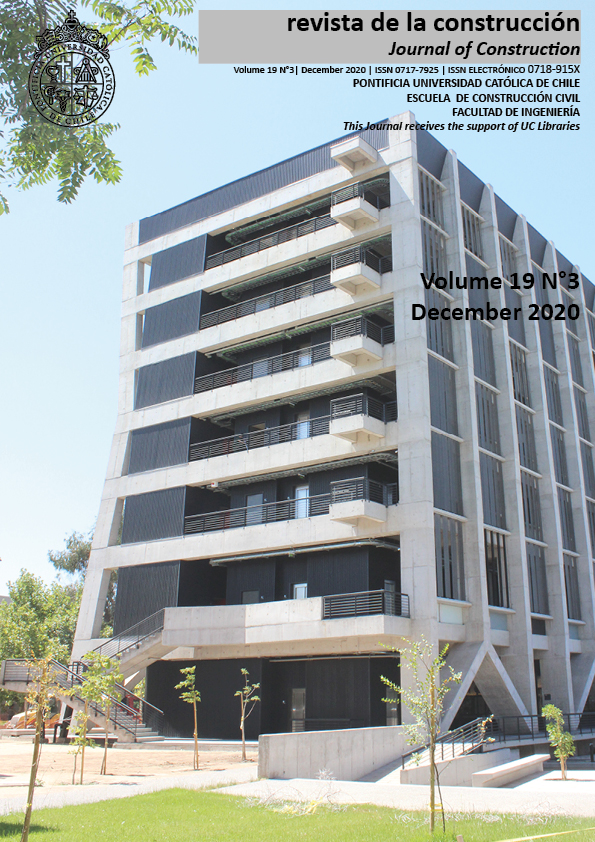Study on the fractal model of water immersed collapse of Soft Rock
DOI:
https://doi.org/10.7764/rdlc.19.3.486-491Keywords:
Slate; disintegration; drying-wetting cycle; fractal dimension; scrapAbstract
Soft rock is a common rock mass in engineering, one of its characteristics is water swelling and disintegration. In this paper, the nonlinear fractal geometry is introduced and the correlation fractal dimension is used to study the characteristics of slate disintegration, based on the laboratory test of water immersion disintegration, the method of quality fractal dimension is used to solve the fractal dimension of the disintegration of slate, and the change of fractal dimension is used to reflect the characteristics of the softening and disintegration of slate when encountering water. The experimental results show that the fractal model can be used to fully understand the development and evolution of rock disintegration process, and to quantitatively link the relationship between rock expansion and disintegration. The conclusion has guiding significance for engineering practice.
Downloads
References
Bandis, S., Lumsden, A.C. and Barton, N.K. (1981). “Experimental studies of scale effects on the shear behaviour of rock joints.” International Journal of Rock Mechanics and Mining Sciences & Geomechanics Abstracts, 18(1), 1-21.
Carulla, R.R., Corominas. J. and Mavrouli. O. (2017). “A fractal fragmentation model for rockfalls.” Landslides, 14(3), 875-889.
Ding, L.J. and Liu, Y.H. (2018). “Study on deformation law of surrounding rock of super long and deep buried sandstone tunnel.” Geomechanics and Engineering, 16(1), 97-104.
Erguler, Z.A. and Ulusay, R. (2009). “Assessment of physical disintegration characteristics of clay-bearing rocks: Disintegration index test and a new durability classification chart.” Engineering Geology, 105, 11-19.
Erguler, Z.A., Shakoor, A. (2009). “Relative contribution of various climatic processes in disintegration of clay-bearing rocks.” Engineering Geology, 108, 36-42.
Gautam, T.P., Shakoor, A. (2016). “Comparing the Slaking of Clay-Bearing Rocks Under Laboratory Conditions to Slaking Under Natural Climatic Conditions.” Rock Mech Rock Eng, 49, 19–31.
Lin, T.K., Chien, Y.H. (2017). “A structural health monitoring system based on multifractal detrended cross-correlation analysis.” Structural Engineering and Mechanics, 63(6), 751-760.
Liu, X.M., Zhao, M.H., Su, Y.H. (2008). “Mathematical simulation of fractal mechanism for slaking of soft rock.” Rock and Soil Mechanics, 29(8), 2043-2069.
Maruvanchery, V., Kim, E. (2019). “Effects of water on rock fracture properties: Studies of mode I fracture toughness, crack propagation velocity, and consumed energy in calcite-cemented sandstone.” Geomechanics and Engineering, 17(1), 57-67.
Sun, W.B., Xue, Y.C., Yin, L.M. (2019). “Experimental study on seepage characteristics of large size rock specimens under three-dimensional stress.” Geomechanics and Engineering, 18(6), 567-574.
Tating, F., Hack, R., Jetten, V. (2013). “Engineering aspects and time effects of rapid deterioration of sandstone in the tropical environment of Sabah, Malaysia.” Engineering Geology, 159, 20-30.
Vtorushin, E.V., Dorovsky, V.N.(2019). “Application of non–stationary non–Euclidean model of inelastic deformations to rock cutting.” Journal of Petroleum Science and Engineering, 177, 508-517.





